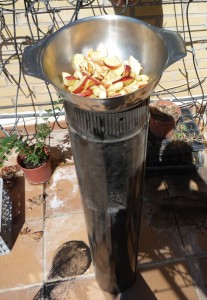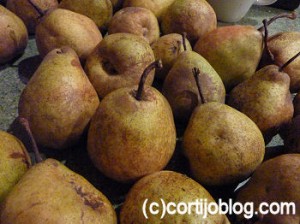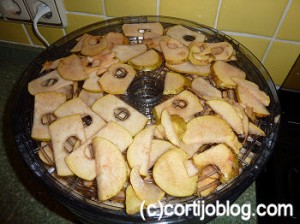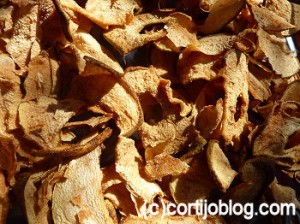In August 2010 I bought some dried Goji berries. At that time they were being touted as the ultimate super food, capable of lowering cholesterol, lowering blood pressure, cleaning the blood and a whole list of other health benefits which it seemed would lead to almost everlasting life. I checked them out on many websites and their growing conditions matched the climate of our cortijo. The can put up with cold down to -15C and also they don’t mind strong sun and drought conditions, I realised that this is the sort of tough as old boots plants we need in the sometimes harsh environment that we have at the cortijo. After some more research I decided to grow some.
The first step was to soak the seeds in water for a day and then break the berries up with my fingers. Then the seeds were put in a kitchen sieve and put under a jet of water. It was easy to separate then from the pulp. I then spread the seeds onto the top of some potting compost in a flowerpot. When some of the seedlings were about 1cm high I transplanted them to plastic growing modules.
 Some of them died but I kept replacing them with other ones from the flowerpot until I had about 50 viable plants.
Some of them died but I kept replacing them with other ones from the flowerpot until I had about 50 viable plants.
Most of the plants had reached about 8cm by October. We then took them down to the coast which has a mild climate with no frost. During the winter they did not lose their leaves but they seemed to be in a dormant state and did not grow much. Supposedly the dormant state was influenced by the hours of daylight.
 We started planting the Goji berries into the ground on the 2nd of May 2011. The holes were about 30cm deep and we filled them with a mixture of manure, bags of garden soil form the garden centre and a little fish blood and bone mixture.
We started planting the Goji berries into the ground on the 2nd of May 2011. The holes were about 30cm deep and we filled them with a mixture of manure, bags of garden soil form the garden centre and a little fish blood and bone mixture.
 Peter designed a system to protect the young plants from rabbits or other unwanted predators. Peter made tubes out of chicken wire which were held in place by bamboo sticks. The advantage of this system is that the wire mesh can be easily pushed up to enable weeding.
Peter designed a system to protect the young plants from rabbits or other unwanted predators. Peter made tubes out of chicken wire which were held in place by bamboo sticks. The advantage of this system is that the wire mesh can be easily pushed up to enable weeding.

Goji berry just after being planted
Although the plants had been in a mild climate on the coast with a fair amount of sun they were only about 12cm high when we planted them.
They were mulched with composted almond shells.
 Goji Berry Grown on the Coast The photo below is a plant that I gave to a friend from the original batch who lives on the coast near Malaga. She kept the pot in a garden and watered it well. This is much better than any of my plants. This just goes to show that the environment is very important.
Goji Berry Grown on the Coast The photo below is a plant that I gave to a friend from the original batch who lives on the coast near Malaga. She kept the pot in a garden and watered it well. This is much better than any of my plants. This just goes to show that the environment is very important.
 Every year I have to buy more Geraniums because at some point the temperature gets down to about -10C and kills them.
Every year I have to buy more Geraniums because at some point the temperature gets down to about -10C and kills them.












